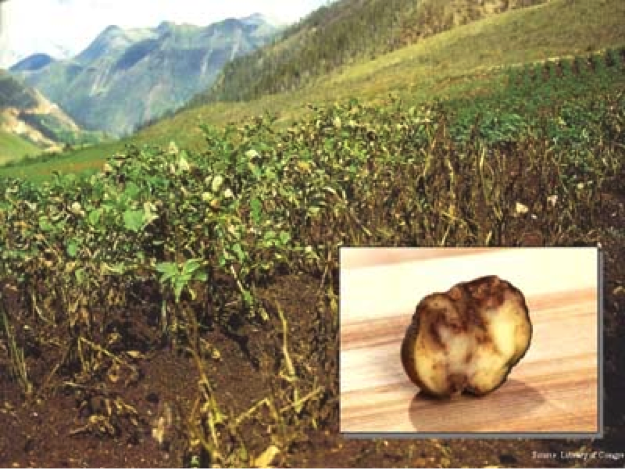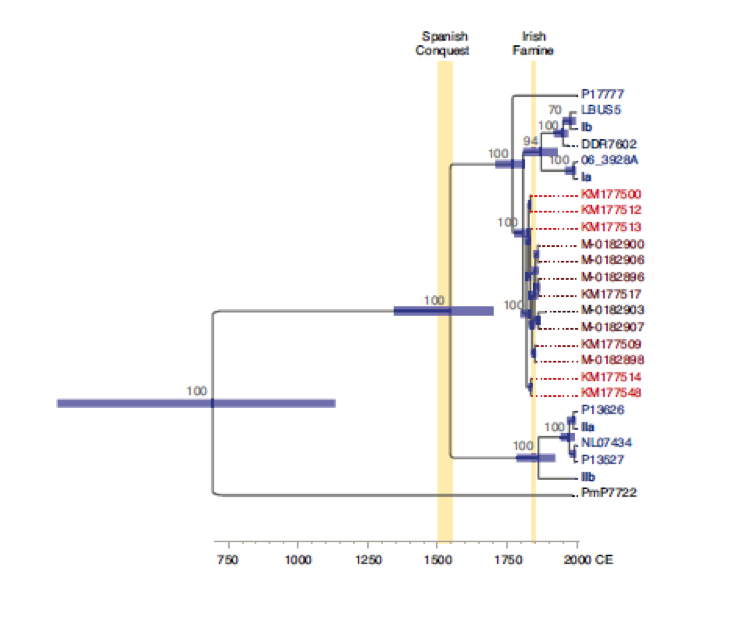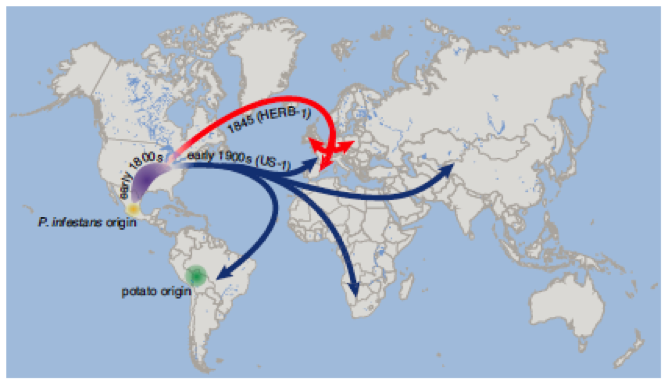
This web page was produced as an assignment for an undergraduate course at Davidson College.
Food Production: Late Blight
The Pathogen Behind the Great Famine

A field and a potato infected with Phytophthora infestans.
From pesticidestewardship. Currently seeking permission to use this photo.
Phytophthora infestans causes late potato blight, which is a disease that causes decay of stems, leaves, and tubers. It is the cause of the Great Potato Famine in Ireland in the years 1845, 1846, and 1848, and continues to have devastating effects on potato crops today. In fact, “worldwide losses in potato production alone caused by late blight exceed $5 billion annually, making P. infestans the single most important biotic threat to global food security” (Broad Institute, 2010). P. infestans is an oomycete, which is “a diverse group of deeply branching eukaryotic microorganisms that includes pathogens of plants, insects, crustaceans, fish, vertebrate animals, and microbes” (Broad Institute, 2010). This pathogen can reproduce asexually through spores, which are carried by the wind and allow easy infection of large areas (Ensembl Protists, 2013). Originally thought to be a fungus because of its filamentous growth, modern analysis has determined that P. infestans is actually more closely related to brown algae and diatoms (Broad Institute, 2010).
Recent pathogenomic research has uncovered aspects of the P. infestans genome that could contribute to its pathogenicity and has even identified the exact strain of P. infestans responsible for the Great Potato Famine. According to Haas et al, comparison to other Phytophthora genomes has identified “rapid turnover and extensive expansion of specific families of secreted disease effector proteins, including many genes that are induced during infection or are predicted to have activities that alter host physiology” (2009). In other words, Phytophthora genomes have been shown to adapt quickly to their environment by modifying genes used to infect the host and producing a lot of protein product from these genes. In contrast, non-pathogenic relatives of Phytophthora have fewer of these same genes (Haas, 2009). P. infestans’s ability to evolve quickly allows it to evade plant resistance and human attempts to eradicate the pathogen, which allows it to continue to spread through potato fields.
After initial pathogenomic research, the US-1 strain of P. infestans was thought to be responsible for the Great Famine. However, further research has shown that in fact the Herb-1 strain was responsible for the outbreak in Ireland (Yoshida, 2009). Yoshida et al obtained infected potato and tomato leaf samples from 1845 to 1896 and used whole genome shotgun-sequencing to gain information about P. infestans mitochondrial and nuclear genomes. They then compared this genome to that of modern day P. infestans and found that the strain responsible for late blight today (US-1) is not the same as the strain responsible for late blight during the Great Famine (Herb-1). In fact, Yoshida et al state that Herb-1 no longer exists at all (2009).
Yoshida et al also used the differences between the 19th century and modern strains to trace the evolutionary history of the pathogen (2009). By creating a phylogenetic tree, they were able to link certain “key events in P. infestans evolution with historic records of human migration and late blight spread” (Yoshida, 2009). Their findings are displayed in the figures below.
In conclusion, pathogenomic research has been helpful in mapping the evolutionary history of P. infestans in addition to identifying key aspects of its genome that are responsible for its pathogenicity, which could help develop a method to fight the pathogen and reduce the number of crops lost to late blight every year.




From Yoshida et al, 2009. Currently seeking permission to use these photos.
Resources:
http://www.broadinstitute.org/annotation/genome/phytophthora_infestans/GenomeDescriptions.html
http://protists.ensembl.org/Phytophthora_infestans/Info/Index
http://www.nature.com/nature/journal/v461/n7262/full/nature08358.html
Assignments:
Assignment #2:You get to choose (due Feb. 28, 2 pm)
Assignment #3: You get to choose (due Apr. 25, 2 pm)
Genomics Page
Biology Home Page
© Copyright 2014 Department of Biology, Davidson College, Davidson, NC 28035